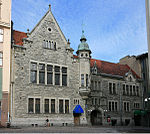Savoy (restaurant)

Savoy is a restaurant in Helsinki, Finland, located on the Eteläesplanadi street. The restaurant opened on 3 June 1937. It is located in a space designed by Finnish architects Aino and Alvar Aalto, and furnished by the company Artek, which they had founded two years earlier. It was renovated in 2019. The Savoy is considered a hallmark of Finish cuisine.The main restaurant hall of Savoy is long and narrow, resembling a tram or a saloon on a ship. The original functionalist interior has been mostly preserved: plywood, wood, slammed brick. The restaurant is also known by the nicknames "Aalto's stable", "giraffe stable" and "elephant stable". The windows on the restaurant hall on the street side have a view to the Esplanadi park. The ground floor has a celebration space. At the time of its opening in 1937, Savoy had four elevators and an air conditioning device keeping the hall clean of cigar smoke, which was unusual at the time.
Excerpt from the Wikipedia article Savoy (restaurant) (License: CC BY-SA 3.0, Authors, Images).Savoy (restaurant)
Eteläesplanadi, Helsinki Kaartinkaupunki (Southern major district)
Geographical coordinates (GPS) Address Phone number Website External links Nearby Places Show on map
Geographical coordinates (GPS)
| Latitude | Longitude |
|---|---|
| N 60.166969444444 ° | E 24.947291666667 ° |
Address
Ravintola Savoy
Eteläesplanadi 14
00130 Helsinki, Kaartinkaupunki (Southern major district)
Finland
Open on Google Maps










